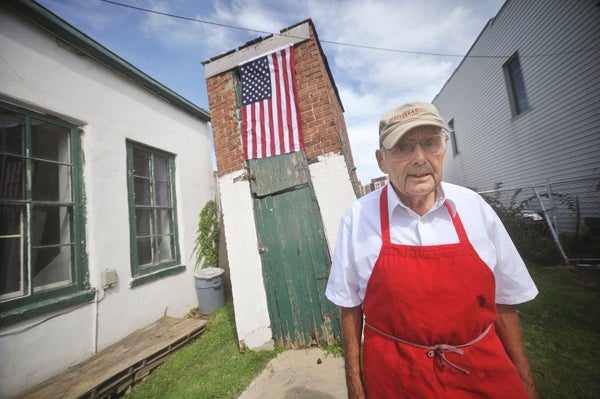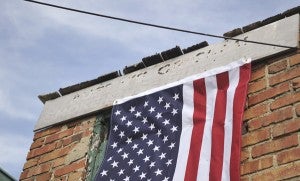Smokehouse harkens back to Austin’s past
Published 5:00 pm Saturday, August 21, 2010

Bob Knauer, owner of Knauer’s Food Market, stands out behind the store with the market’s original smokehouse Tuesday. Bob wants to restore the building back to its original condition. - Eric Johnson/photodesk@austindailyherald.com
Sketched in sun-bleached and faded print, the sign on the crumbling, tilted two story building behind Knauer’s Food Market reads, “Austin’s Original Smokehouse Since 1886.” The smokehouse is over 110 years old with a history that mirrors the changes Main Street has gone through over the years.
The smokehouse’s construction design reflects the time it was built, with its lack of foundation and simple brick and mortar material. In recent decades, the smokehouse’s lack of foundation has become a liability. In 1975, the smokehouse began to tilt as the dirt underneath it settled. The building continued to sag over the next 10 years before resettling.

Though it’s difficult to see, the words “Austin’s Original Smokehouse Since 1886,” are still visible above the old smoke house. - Eric Johnson/photodesk@austindailyherald.com
“It’s Austin’s own Leaning Tower of Pisa,” said Mark Knauer, son of store owner Bob Knauer.
Bob Knauer said that he is interested in restoring the building back to its original condition. He said he is currently considering lobbying the Mower County Historical Society for help to fix the smokehouse’s slump. He has not yet filed any paper work.
“Preserving the smokehouse isn’t for me. It’s a downtown landmark. People come and take pictures of it. They say it’s kind of the original downtown Austin,” said Bob Knauer.
The smokehouse was built in 1886, when Tony Knauer bought the building that became Knauer’s Meat Market. Tony was a sausage maker from Germany that immigrated to America and settled in Austin. He was among the many immigrants that settled in the area at that time.
“Tony taught himself to speak just about any language. That made it easier for the immigrants to talk about what they wanted to buy,” said Bob Knauer, who is Tony’s grandson and the current owner of the store. “He was a real sausage maker, a good one.”
Since Tony Knauer died, Knauer’s and the smokehouse have been passed down the family for generations until it came into the ownership of Bob, who works it with his son and his grandchildren. He believes that the smokehouse needs to be preserved to mark that period in Austin history.
During 1880, the smokehouse held an essential function for community members. The lack of preservation technology made smoke curing the premiere way to preserve meats. This made owning a smokehouse essential to the profession of meat cutting, and an important tool for the community. Austin residents, especially farmers who butchered meat, would travel from all over the area to have their meats cured at Knauer’s. Depending on the time of the year, Knauer’s would cure large amounts of meat for anywhere from five to 25 customers a week.
The method used to cure meat was burning a variety of wood at the base of the smokehouse so that heat and smoke would reach the meat hanging from the ceiling of the first and second floors. Which floor the meat was hung on and the length of time it was left in the smoke would determine how intense the meat was cured. In addition, the flavor the smoke would produce in the meat could be determined by what type of wood was burned in the fire.
“A lot of times, there was more work out back than there was out front,” Bob Knauer said.
Despite the utility the smokehouse offered, there was still an element of danger involved. While the meats where smoked, flammable grease would drip off the food.
When it hit the fire at the fire at the bottom of the smokehouse, the grease would cause minor flare ups. If the flare ups where not constantly monitored, wooden portions of the structure, like the doors and the divider between the two levels, could catch fire. Bob Knauer said the Knauer smokehouse had caught fire at least 20 times in its history. He joked that they would set the smokehouse on fire once a week.
In the earlier parts of the 1900s, the smokehouse was as active as Austin’s Main Street. Businesses filled up every open space in the middle of town, vying for customers and their money.
“Main street used to be so packed on a Friday night that you couldn’t get anywhere,” Knauer said.
As the 1930s came along, the signs of the Depression could be seen at the smokehouse. Homeless men on the move would gather near smokehouse in the morning, begging for the ability to perform small tasks like splitting wood in order to earn a small sum of money.
The smokehouse was eventually closed in 1955 as the rise of refrigerators made its role obsolete. Technological advances pushed aside the smokehouse the same as changing, postwar culture pushed aside the way American used to act. Since then, the smokehouse has remained unused behind Knauer’s, a momument to an older time in Austin.
Knauer said that he recently overcame health complicatons, which has prevented him from having enough time yet to approaching the Historical Society about restoring the smokehouse. He said he still feels that it can be restored.
“I just want to make sure it’s safe. I mean, people are willing to drive to Austin to take pictures of it. It’s something to think about,” Knauer said.





